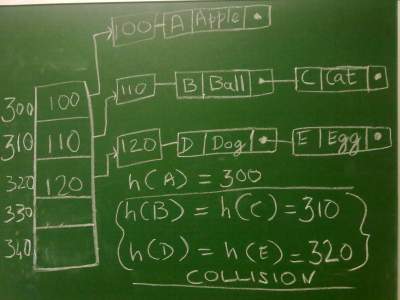When we try to restrict the hashing function’s output within the allocated address spectrue limit, there is a possibility of a collision. For two different keys k1 and k2, if we have h(k1) = h(k2), then this is called collision in hashtable. What does this mean, our hashing function directs us store two different values (keys are also different) in the same location.
When we have a collision, there are multiple methodologies available to resolve it. To name a few hashtable collision resolution technique, ‘separate chaining’, ‘open addressing’, ‘robin hood hashing’, ‘cuckoo hashing’, etc. Java’s hashtable uses ‘separate chaining’ for collision resolution in Hashtable.
Collision Resolution in java’s Hashtable
Java uses separate chaining for collision resolution. Recall a point that Hashtable stores elements in buckets. In separate chaining, every bucket will store a reference to a linked list. Now assume that you have stored an element in bucket 1. That means, in bucket 1 you will have a reference to a linked list and in that linked list you will have two cells. In those two cells you will have key and its corresponding value.

Why do you want to store the key? Because when there is a collision i.e., when two keys results in same hashcode and directs to the same bucket (assume bucket 1) you want to store the second element also in the same bucket. You add this second element to the already created linked list as the adjacent element.
Now when you retrieve a value it will compute the hash code and direct you to a bucket which has two elements. You scan those two elements alone sequentially and compare the keys using their equals() method. When the key mathches you get the respective value. Hope you have got the reason behind the condition that your object must have hashCode() and equals() method.
Java has a private static class Entry inside Hashtable. It is an implementation of a list and you can see there, it stores both the key and value.


0 comments:
Post a Comment